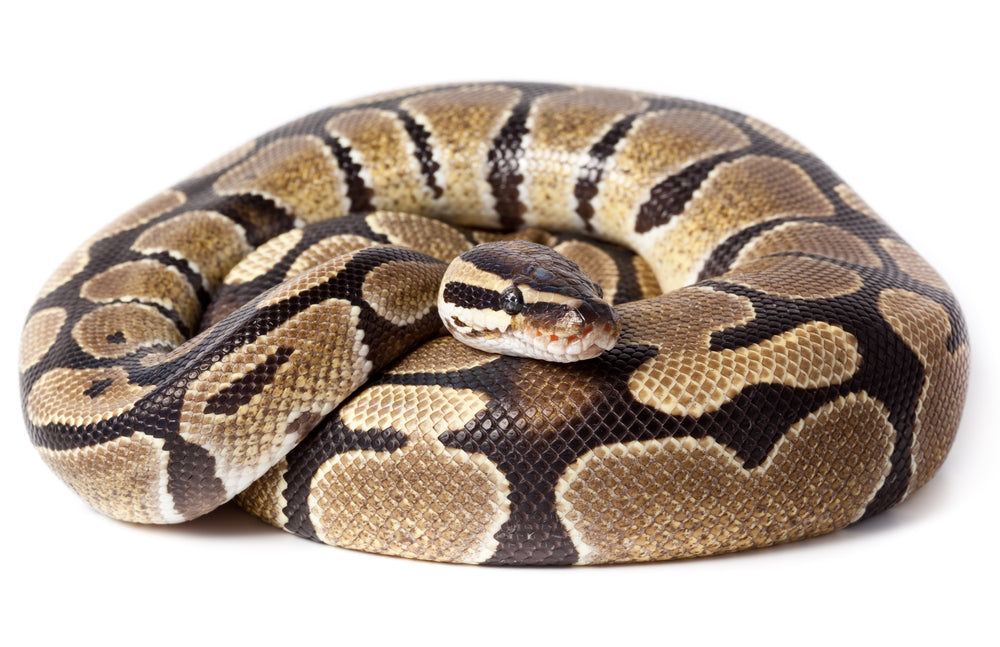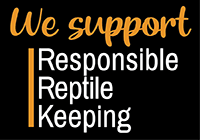Ball Python Care Guide

Ball Python (Python regius)
Difficulty: Intermediate
Ball pythons are a terrestrial species of constricting snake native to regions of eastern, central, and western Africa. In the wild they are most often found in semi-arid grasslands, sparse woodlands, and in farm fields, sheltering in burrows and hollow logs.
These snakes are crepuscular, which means that although they are active at night, they are most active around dawn and dusk. Like other snakes, ball pythons are carnivorous, and they use this time to hunt prey such as rodents and birds.
Male ball pythons typically grow 2-3’ long while females grow to be 3-5’ long. Larger individuals have been recorded. These snakes reach adulthood in 3-5 years and have a 15-30 year lifespan in captivity.
Ball pythons are very common in the reptile hobby and in the pet trade in general. Part of this is due to morph breeding, which is the practice of selectively breeding reptiles to produce new colors and patterns not found in nature. At the moment, there are about 6500 known morphs.
Ball pythons can make good pet snakes for first-timers due to their docile temperaments, slow movement, and manageable size.
What You Need for a Pet Ball Python:
- 4’x2’x2’ front-opening enclosure
- Exo Terra Reptile Deep Dome Fixture Large
- Zoo Med Basking Spot Lamp 150 Watt
- plug-in lamp dimmer
- Arcadia Forest D3 6% UVB T5 Bulb 22"
- The Bio Dude Solar Grow T5 HO Single Bulb Light Strip 24" (for UVB)
- The Bio Dude Solar Grow 36” light and fixture
- Daisy Chain (to connect your two Solar Grows)
- Terra Firma Bioactive Kit 4' x 2' x 2' PVC Kage
- Ball Python Clean Up Crew Pack
- large water bowl
- 2+ hides/caves
- large flat basking stone
- temperature gun
- Bio Dude Digital Thermometer / Hygrometer
- Decorations: thick branches, plants, cork logs, etc.
- Exo Terra Reptile Multivitamin
- 12” soft-tipped feeding tweezers
Terrarium Size
When it comes to choosing a terrarium for pet reptiles, keep in mind that larger is always better! There is a common myth that ball pythons prefer small, cramped spaces, but this is not true. Tiny enclosures that prevent a ball from being able to full stretch out as needed promote obesity as well as decrease the snake’s overall quality of life. So the minimum enclosure size recommended by modern ball python experts is 4’x2’x2’.
It’s best to choose a front-opening enclosure with a covered top, which makes accessing the snake much easier (and less startling for the snake).
Ball pythons should not be housed together in the same enclosure.
Lighting
Ball pythons are crepuscular (active at night, particularly dawn and dusk), so they benefit from having a light in their enclosure to regulate their day/night cycle.
There is a common myth that ball pythons are stressed by light. There is another myth that snakes do not “need” UVB light for survival and therefore providing it as part of their habitat in captivity is unnecessary. Both are completely false and do not reflect the snake’s native habitat. Our goal as good reptile keepers is not to simply allow our pets to survive — it is to do everything in our power to enable them to thrive. And there is mounting scientific evidence that UVB is, in fact, beneficial to ball pythons and other snakes.
Therefore we recommend installing a Zoo Med T5 HO ReptiSun 5.0 or Arcadia Forest 6% in a reflective T5 HO fluorescent fixture, long enough to cover about 1/2 of the enclosure’s length. So for a 48” long enclosure, you will want a bulb about 22-24” long. Do not use other brands — when it comes to UVB, brand matters!
In a 24” tall enclosure, it is best to install the UVB fixture under the mesh instead of over it, as the mesh will block a significant portion of the UVB light and your snake may not get enough. This can be done most easily with zip ties.
Heating
Because ball pythons are reptiles, they are cold-blooded, and that means that they need a range of temperatures within their enclosure so they can regulate their own body temperature as needed. Areas of heat speed up their metabolism and promote activities like digestion and healing. Cool areas slow the metabolism and promote activities like rest and energy conservation.
The warm side of a ball python’s enclosure should be between 90-95°F, and the cool side should be between 75-80°F. For best results, place one of your ball python’s hides directly below the heat lamp so it can get nice and warm.
Many ball python keepers recommend using heat pads as the snake’s primary source of heat, but heat pads don’t work well in a bioactive enclosure because they have to compete with a thick layer of substrate, and thus can become a fire hazard. Instead, use a heat bulb like the Zoo Med Basking Spot Lamp 150 Watt or Philips 100w PAR38 Halogen Flood Heat Bulb in a dome heat lamp. Plug the heat lamp into a lamp dimmer so you can control it if it gets too hot.
The most accurate way to keep track of your terrarium’s temperature gradient is to use a temperature gun. They’re super reliable and essential for monitoring surface temperature, which is the temperature that your ball python will be feeling on the ground.
Humidity
Ball pythons need humid air in their environment in order to stay hydrated, keep their lungs healthy, and shed their skin safely. To be specific, they need an average of 55-65% ambient humidity, although areas of low humidity (40%) and areas of high humidity (80%) are perfectly acceptable as part of your enclosure’s gradient. Keep track of your humidity levels with a digital hygrometer like the Bio Dude Digital Thermometer / Hygrometer, with the probe placed on the cool side of the enclosure, preferably inside of the cool hide.
A large water bowl will help, but regular misting with distilled water in a pressure sprayer like the Exo Terra Mister is recommended. It also helps to provide a “humid hide” lined with damp sphagnum moss, which should be the most humid spot in the enclosure. Since you have a bioactive enclosure you may not have to worry about the moss getting moldy, but make sure to check on it regularly and replace as needed.
If you have live plants as part of your bioactive setup, the regular watering that they require will also help keep humidity levels within the appropriate range. As an added bonus, plants’ leaves release water into the air, further boosting ambient humidity!
Substrate
To create a bioactive ball python vivarium, you will need a bioactive-compatible substrate. That means things like coconut husk or cypress mulch aren’t going to work. You need a soil-like mix that mimics the conditions of your ball python’s natural habitat. You can make your own with 2 parts organic topsoil, 2 parts Zoo Med Reptisoil (or similar), and 1 part play sand, or you can let The Bio Dude do the work for you with a 4' x 2' x 2' PVC Kage Terra Firma Bioactive Kit.
Because you’re setting up a bioactive habitat, you will need to mix and layer the substrate with sphagnum moss and plenty of leaf litter. For best results, combine with an appropriate amount of Bio Dude Bio Shot reptile-safe fertilizer.
Decorating the Enclosure
Enclosure décor is more than just making your setup look good. It’s also an important part of providing environmental enrichment to your ball python, which enhances your pet’s quality of life by providing opportunities to express natural behaviors, explore, and exercise. And since ball pythons like to hide and occasionally climb, feel free to clutter it up!
Contrary to popular believe, ball pythons are not “pet rocks” that are content to live in a virtually empty box. They are complex animals that we are just beginning to understand. Here are some ideas for ways that you can decorate and enrich your ball python’s bioactive enclosure:
- hollow cork logs
- thick, sturdy branches
- hides/caves
- plants
- décor
Feeding Your Ball Python
Ball pythons are obligate carnivores, which means that they must eat whole animals in order to get the nutrition they need. There is no replacement. Here is a rough chart of how much and how often you should be feeding your ball python, based on snake weight.
- >200g — rat fuzzy or small mouse every 7 days
- 200-350g — rat pup or adult mouse every 7-10 days
- 350-500g — weaned rat every 10-14 days
- 500-1500g — small rat every 14-21 days
- >1500g — medium rat every 28-56 days
Always feed your snake inside its enclosure, not outside. Contrary to the myth, feeding inside does not make snakes more aggressive. Also, use feeding tweezers to offer the rat, not your hand.
Variety is essential to complete nutrition. You can add variety to your ball python’s diet with African soft-furred rats, chicks, quail, and Reptilinks. Do not offer live prey if it can be avoided, as live rodents may injure your snake in the process of feeding. Instead, buy frozen prey and thaw to 100°F internal temperature in warm water.
Handling Tips
After bringing your new pet home, do not handle it until it is eating regularly. This can take anywhere from two weeks to two months, so be patient and use this time to make sure your husbandry is on point. Once your snake is ready for handling, handle it at least 1-2x weekly to keep it accustomed to you, but no more than once daily.
Wash Your Hands First
Before you pick up your ball python, first wash your hands with soap or hand sanitizer. This removes potentially harmful bacteria, viruses, or parasites from your hands, as well as makes your hands smell distinctly inedible. Ball pythons find prey via heat and smell. If your (warm) hands smell like rat, animal, or anything else remotely appetizing, your pet may confuse you for food.
How to Pick Up a Snake
Next, use a paper towel roll to tap its head (gently). This sets expectations by letting the snake know that it’s time for handling, not food. Pick it up with two hands, one behind the head and one supporting the rest of the body. NEVER pick up a snake by its tail — this can really hurt their spine!
Safety with Snakes
Always supervise children closely when they are handling a pet snake (or any kind of pet, frankly). This is as much for the snake’s safety as it is for the child’s. Keep the snake’s head away from your face, and don’t let it wrap around your neck. Ball pythons don’t try to hurt humans, but they are strong enough to cause accidents.
DO NOT Handle If…
Don’t handle your snake within 48 hours of a meal, as this can stress them out and lead to regurgitation, which is a traumatic experience that can actually lead to death. Also do not handle if your pet’s eyes have turned opaque or cloudy. This means that the snake is preparing to shed and can’t see well, making them more jumpy than usual and more likely to bite out of self-defense.
Care information courtesy of ReptiFiles. Visit ReptiFiles.com for further information on ball python care.
- Tags: Ball Python ReptiFiles
- Josh Halter










